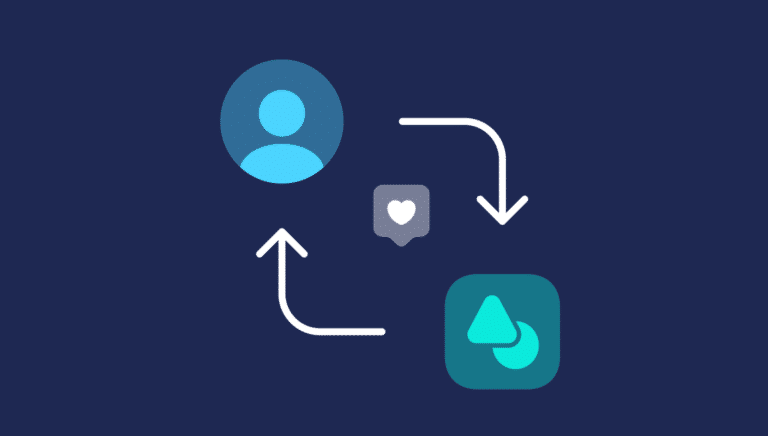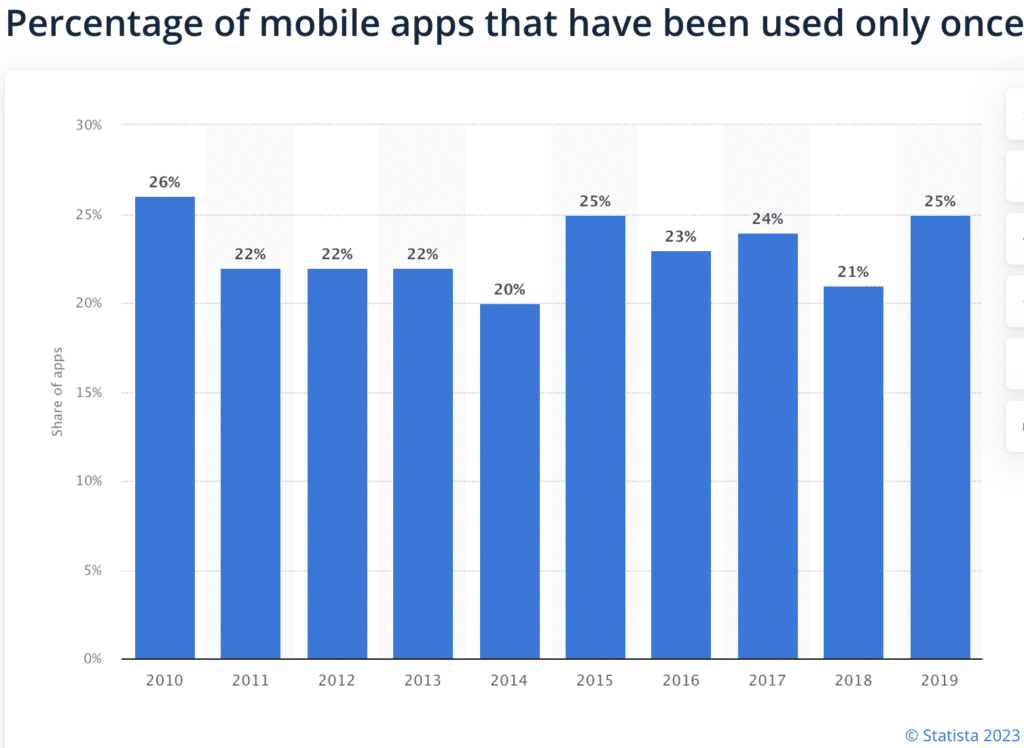When it comes to mobile apps, first impressions matter. In fact, research shows that up to 25% of app users abandon an app after using it just once. Getting downloads is so much easier than retaining users. This is why mobile app onboarding is so important. Onboarding is the process of introducing users to your app and guiding them through its features and functionality. Done right, it can help increase user engagement, drive revenue, and improve retention.
In this blog, we’ll discuss some best practices for onboarding users to your mobile app. In short, keep it simple, smooth and personalized.
What are the different types of mobile app onboarding?
Mobile onboarding types can take various forms, each with its unique set of advantages and challenges. Onboarding flow involves a step-by-step tutorial that walks users through the app’s features in several different ways, including:
1. Progressive
A progressive onboarding process allows users to explore and access new information, with prompts related to each specific page, as they navigate the app.
This type of onboarding is great for apps with an intricate workflow, hidden functionalities, or gesture-driven interactions.
Progressive onboarding example: Hotel Tonight
Getting a friend to try Hotel Tonight is made easier than ever with their progressive onboarding process. You simply refer a friend with a personalized offer, and they will be brought to the web onboarding experience to reduce friction. Then, after initial setup, they are brought to the promotional offer in the Hotel Tonight app, so they can start booking right away.
2. Functional
In this onboarding strategy, an app immediately shows new users the app’s core functions and how to use them. More specifically, function-oriented onboarding shows users where to start and how to execute common actions.
Usually, this approach consists of a visual tour with specific details as the user moves along.
3. Benefits-oriented
This approach showcases the benefits of the app or the app’s value proposition. The goal is to increase conversions and app engagement. Generally, the onboarding screens will describe what the app does without elaborating on how to use the app.
Benefits-oriented app onboarding example: Ecobee
The value of Ecobee is in being a smart thermostat that can help your house be more efficient in heating and cooling so you save money in the long run. They have made it very easy to invite family members to join your household so everyone can help keep costs down. To do so, Ecobee has chosen a benefits-based onboarding experience that educates an invited member on key benefits before immediately adding them to the household account.
The key is to choose the best experience for your type of app functionality and potential customers. If you’re not sure, you may want to do some testing or research to better understand how to ensure you have an onboarding experience that will drive growth and help you meet your goals faster.
Now that you are familiar with the traditional types of mobile app onboarding strategies, let’s review the benefits they offer.
What are the benefits of mobile app onboarding?
The app onboarding process is critical to creating engaged users who do what you want them to do, like spend money and come back again. Here are the key benefits of developing a mindful mobile app onboarding process, including:
Increase engagement
Personalized app onboarding can help users quickly understand the value of the app and how it can benefit them. Bringing users directly to the content they want (e.g., Branch deep links) or by showcasing the importance of the core app features will drive more engagement and reduce the likelihood of a user uninstalling the app.
Improve app user retention rates
Your ultimate goal is to make your app an absolute favorite for users. By guiding users seamlessly toward valuable new features and functions, users are more likely to understand how the app works and what they can do with it. When users are clear about how to use an app, they are less likely to get frustrated and abandon it.
Drive revenue
When users have a positive onboarding experience, they are more likely to continue engaging with the app. This improves user engagement and retention, which in turn drives revenue. A smooth onboarding experience creates a higher chance of converting users into paying customers and increasing their lifetime value.
Higher user satisfaction
Onboarding is an opportunity to gather information about the user’s preferences and behavior. This data can be used to provide personalized recommendations, which leads to higher user satisfaction, better reviews and stronger ratings.
Overall, app onboarding is an important component of creating a successful app and helps improve user engagement, retention, and satisfaction.
Mobile app onboarding best practices
To ensure users continue to use your app after they download it, follow these onboarding best practices:
Personalize the user experience
Create a personalized onboarding experience by leveraging deep links to ensure that first-time users are taken directly to relevant content in your app, even after install. Utilizing deep links in this way makes the onboarding process more seamless and impactful. The experience of taking the new user directly to the desired content in your app, after an app is installed, is called deferred deep linking.
Understand user behavior
Make sure to capture user behavior and engagement throughout the app onboarding process with analytic and measurement partners such as Branch, Adobe, Braze and Amplitude. This data and their visual dashboards can help you identify where users are coming from, why they are dropping off, and opportunities for optimizing the onboarding experience.
Keep it simple
One of the biggest mistakes app developers make is overwhelming users with too much information during onboarding. You should also consider if it makes sense to have users skip the onboarding process and bring them directly to the relevant content, allowing them to onboard later. Basically, keep the onboarding process short and to the point, highlighting only the most important features and benefits of your app.
Test and learn
Finally, it’s important to test and iterate throughout the onboarding process by performing A/B testing to determine which onboarding strategies are most effective. By testing different CTAs and experiences, including skipping onboarding, you can analyze user behavior and identify areas where mobile users are struggling or dropping off during onboarding. Apply this information to improve your onboarding experience and retention metrics over time.
Exploring app onboarding examples
Every app should have some sort of onboarding process. Here are some examples of brands that are taking the mobile app onboarding experience to the next level.
Robinhood
Robinhood uses a personalized experience for their ‘free share’ referral program that skips onboarding. Once a referred user receives a notification and downloads the app, they are deep linked directly to the specific page in the app where they can redeem their free share of stock. The user can then opt to either start trading immediately — thus delaying the onboarding process — or configure their account and onboard prior to starting to trade. This helps customers get a feel quickly for how easy and convenient the app is to use.
Slack
Slack is an app designed specifically to facilitate communication among teams of small and large enterprises. It displays its key features right when opening the app so users can get started right away. Slack practices value-oriented onboarding which allows users to see how they can get started with communicating and sharing data among teams while leaving the bigger features for the user to explore and learn.
Trip.com
The Trip.com mobile app relies on customization to deliver a personalized user experience, based on users’ interests, time of day, local weather, and location. The intention is to help users discover the best things to do, eat, explore etc. in whatever city they choose. It also only asks a user to sign up at the end of the onboarding experience — after they have gotten a sense of the value of the app — or they can skip the setup process altogether. It is a great way to let the user feel in control of their experience.
A personalized onboarding experience is key to revenue growth
Hopefully by now you have a clear understanding how the mobile app onboarding process is a critical step in creating a positive user experience for your app that drives engagement and revenue. With Branch, you are able to personalize the mobile app onboarding process with custom parameters that will link new users to specific content in the app, allowing you to route to a welcome discount, personalized greeting, or product tour.
Given that 63% of customers think onboarding is key to deciding to subscribe to a product and 74% of potential customers will switch to other solutions if the onboarding process is complicated, thoughtful mobile app onboarding is essential to engage and retain app users. By leveraging personalization, measurement partners, dynamic visuals, and testing you are able to create a seamless and engaging onboarding experience for your users that builds loyal users and long-term success for your mobile app.




























